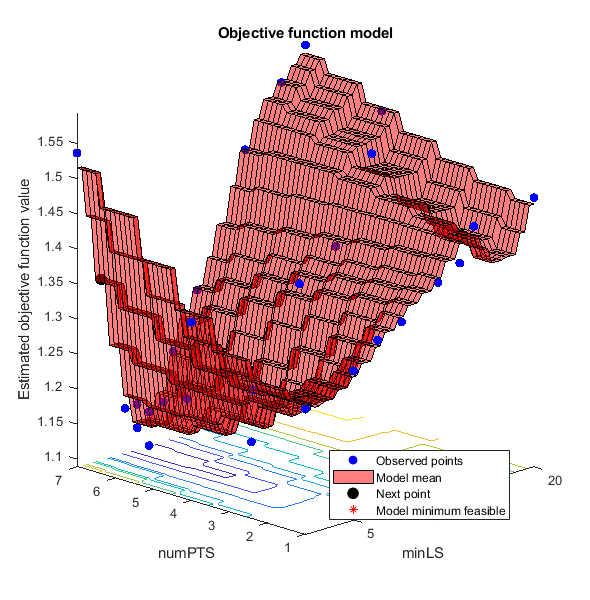Tune Random Forest Using Quantile Error and Bayesian Optimization
This example shows how to implement Bayesian optimization to tune the hyperparameters of a random forest of regression trees using quantile error. Tuning a model using quantile error, rather than mean squared error, is appropriate if you plan to use the model to predict conditional quantiles rather than conditional means.
Load and Preprocess Data
Load the carsmall data set. Consider a model that predicts the median fuel economy of a car given its acceleration, number of cylinders, engine displacement, horsepower, manufacturer, model year, and weight. Consider Cylinders, Mfg, and Model_Year as categorical variables.
load carsmall Cylinders = categorical(Cylinders); Mfg = categorical(cellstr(Mfg)); Model_Year = categorical(Model_Year); X = table(Acceleration,Cylinders,Displacement,Horsepower,Mfg,... Model_Year,Weight,MPG); rng('default'); % For reproducibility
Specify Tuning Parameters
Consider tuning:
The complexity (depth) of the trees in the forest. Deep trees tend to over-fit, but shallow trees tend to underfit. Therefore, specify that the minimum number of observations per leaf be at most 20.
When growing the trees, the number of predictors to sample at each node. Specify sampling from 1 through all of the predictors.
bayesopt, the function that implements Bayesian optimization, requires you to pass these specifications as optimizableVariable objects.
maxMinLS = 20; minLS = optimizableVariable('minLS',[1,maxMinLS],'Type','integer'); numPTS = optimizableVariable('numPTS',[1,size(X,2)-1],'Type','integer'); hyperparametersRF = [minLS; numPTS];
hyperparametersRF is a 2-by-1 array of OptimizableVariable objects.
You should also consider tuning the number of trees in the ensemble. bayesopt tends to choose random forests containing many trees because ensembles with more learners are more accurate. If available computation resources is a consideration, and you prefer ensembles with as fewer trees, then consider tuning the number of trees separately from the other parameters or penalizing models containing many learners.
Define Objective Function
Define an objective function for the Bayesian optimization algorithm to optimize. The function should:
Accept the parameters to tune as an input.
Train a random forest using
TreeBagger. In theTreeBaggercall, specify the parameters to tune and specify returning the out-of-bag indices.Estimate the out-of-bag quantile error based on the median.
Return the out-of-bag quantile error.
function oobErr = oobErrRF(params,X) %oobErrRF Trains random forest and estimates out-of-bag quantile error % oobErr trains a random forest of 300 regression trees using the % predictor data in X and the parameter specification in params, and then % returns the out-of-bag quantile error based on the median. X is a table % and params is an array of OptimizableVariable objects corresponding to % the minimum leaf size and number of predictors to sample at each node. randomForest = TreeBagger(300,X,'MPG','Method','regression',... 'OOBPrediction','on','MinLeafSize',params.minLS,... 'NumPredictorstoSample',params.numPTS); oobErr = oobQuantileError(randomForest); end
Minimize Objective Using Bayesian Optimization
Find the model achieving the minimal, penalized, out-of-bag quantile error with respect to tree complexity and number of predictors to sample at each node using Bayesian optimization. Specify the expected improvement plus function as the acquisition function and suppress printing the optimization information.
results = bayesopt(@(params)oobErrRF(params,X),hyperparametersRF,... 'AcquisitionFunctionName','expected-improvement-plus','Verbose',0);


results is a BayesianOptimization object containing, among other things, the minimum of the objective function and the optimized hyperparameter values.
Display the observed minimum of the objective function and the optimized hyperparameter values.
bestOOBErr = results.MinObjective bestHyperparameters = results.XAtMinObjective
bestOOBErr =
1.0890
bestHyperparameters =
1×2 table
minLS numPTS
_____ ______
7 7
Train Model Using Optimized Hyperparameters
Train a random forest using the entire data set and the optimized hyperparameter values.
Mdl = TreeBagger(300,X,'MPG','Method','regression',... 'MinLeafSize',bestHyperparameters.minLS,... 'NumPredictorstoSample',bestHyperparameters.numPTS);
Mdl is TreeBagger object optimized for median prediction. You can predict the median fuel economy given predictor data by passing Mdl and the new data to quantilePredict.
See Also
oobQuantileError | TreeBagger | bayesopt | optimizableVariable